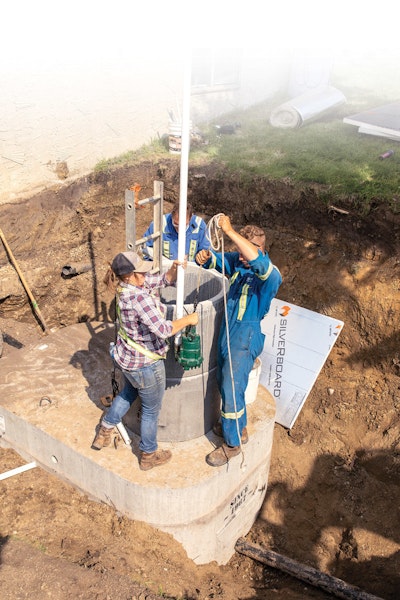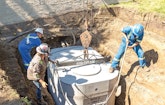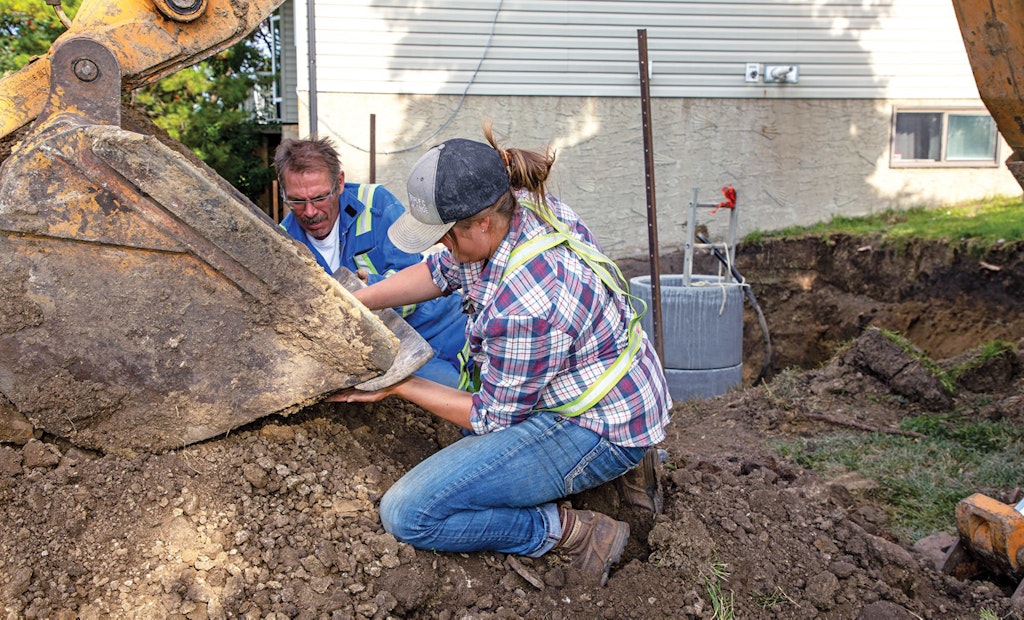Megan Careless can remember years ago when her father and grandfather used straw for septic system drainfield media.
She recalls when open discharges without drainfields were more common than trench-and-pipe systems. And when earning an installer license meant just three days of schooling.
The onsite world is different now, and Megan, her brother Jake Careless, and their father Clay Careless are on board with the changes. The three operate Triple C Backhoe Services in Leduc, Alberta, about 20 minutes south of Edmonton.
They specialize in onsite system installation, repair and inspection, but also do trenching for utilities in subdivisions, snow removal, grave digging and some landscaping. They’re carrying on a family business started in 1988 by Megan and Jake’s late grandfather (Jack), and later joined by their uncle Robert Careless and their dad.
Cycles to septics
Jack Careless started in business in the early 1970s with a Honda motorcycle dealership. He started doing backhoe work on the side with a local contractor. “He ended up enjoying it,” says Megan. In 1976, the Honda shop burned down. He rebuilt it in a new location, but the business never recovered, so he turned to backhoe work. That became the focus of the family enterprise, and work in the onsite sector began in earnest in the early 1990s.
“Jake started working with the company shortly after high school,” says Megan, 29. “I worked a little bit when I was younger, and then I moved away.” She went to school, became a journeyman motorcycle mechanic, and worked for several years in shops in northern Alberta. When her grandfather died in 2019, she moved back home to join Triple C.
Megan took charge of replacing her grandfather as the company’s license holder for system design and installation. To do so, she had to complete an intensive course required by the provincial Ministry of Municipal Affairs and presented by the Alberta Onsite Wastewater Management Association.
“When my grandpa took it, it was a three-day course and here’s your ticket,” she says. “That changed in 2018. Now it’s a lot more in-depth. It’s eight days, plus one field day. It’s a soil sample day where they take you out and dig a couple of test pits and give you a rundown. You actually do a test on those pits.”
Megan mostly runs the office but also helps with the fieldwork. Jake, 24, hauls the equipment and drives the company’s 1990 Mack hauling truck and 1981 Mack gravel truck. Clay is the primary equipment operator. Miles Hammerschmidt lends a hand part time in the field. The earth-moving equipment inventory includes a 1999 Case 580 Super L rubber-tired backhoe, a 2010 Case 580 Super N Series 3 rubber-tired backhoe, 1989 Case 760 trencher and 1999 Case 1845C skid-steer.
Going with growth
The greater Edmonton area is growing with abundant well-paid jobs in the oil industry. In Triple C’s territory of Leduc County, large acreages are being subdivided into parcels of five acres and smaller. The company installs 15 to 20 new systems each summer, and there is ample work in inspecting, repairing and replacing tanks and systems, many installed by Jack Careless years ago.
“Usually, if an owner wants to subdivide a property they’ll have to do an inspection for the county,” Megan says. Inspections include checking system setbacks, checking the tank’s condition, ensuring that the tank size is adequate for the home, and making sure the tank has a secure lid. Pumps, floats, high-water alarms and other components are also examined.
Drainfield inspection is difficult in the absence of inspection ports, which are a relatively new development locally: “With the field, if there’s not a lot of standing water, it should be OK.”
Many existing systems are open discharge, and Triple C still installs them on lots of at least 10 acres, subject to substantial setback requirements. “Effluent drains from the house into a tank,” says Megan. “Then it gets pumped to a discharge that comes out of the ground; the effluent falls onto the ground and dissipates into the soil.
“Before you can even choose to do an open discharge you have to do at least one test pit and take soil samples.” Then the discharge has to be at least 50 meters (165 feet) from any private well, 100 meters (328 feet) from a municipal well, 90 meters (295 feet) from a lake, stream or property line, and 45 meters (148 feet) from any building. Septic tanks have their own set of setbacks.
Making it modern
Today, Triple C’s work increasingly includes conventional trench-and-pipe systems and the occasional mound. Soils in the service territory are generally high in sand and favorable for systems. In the past three years, heavy rain has tended to slow down progress on installations.
The permitting process is straightforward. Mounds and conventional drainfields require two test pits. Triple C team members use Munsell soil color charts to identify soil types, perform manual texturing and ribbon tests, and send spoil samples to the Element Materials Canada laboratory. After the soil-loading rate is determined, Megan creates the system design and submits it to the county health department for approval. A county staff member inspects the installation before backfilling.
For conventional systems, Triple C uses precast concrete septic tanks, typically 1,200 to 1,400 imperial gallons (1,440 to 1,680 U.S. gallons). “You have to take into consideration the size of the home by bedrooms, and whether they have a garbage disposal or a big Jacuzzi tub,” says Megan. “There are a lot of variables when sizing a tank.”
Quick4 chambers (Infiltrator Water Technologies) are the drainfield media of choice. Triple C systems involve pumps from a variety of manufacturers; the conventional systems use pressure distribution.
Repairs and replacements account for roughly half of the company’s business. Calls are commonly triggered by backups and pump failures. “Over time, the tank starts breaking down,” Megan says. “A chunk of concrete falls and then the pump sucks it up. That’s usually the first sign — the pump is shot. Then we look down into the tank, and it’s deteriorating or leaking. The retaining wall between the liquid side and the solid side of the tank is usually the first to go.
“When we do a pump replacement, sometimes we find little things that aren’t correct that we change,” Megan says. “If they don’t have a high-water alarm, that’s a huge thing. It’s a $400 touch, but it’s insurance that their tank isn’t going to back up into your basement. A high-water alarm on a separate circuit with the pump is a provincial requirement, as is an effluent filter and a secure lid.”
Diversification wins
Triple C benefits from a good reputation built over decades and from close relationships with county regulators. The diversity of work also leads to new business. “We work with contractors who do water well drilling,” Megan says. “Generally, if someone is building on acreage, they drill a well. We go in and trench the waterline. Usually they need a septic system as well, so we get spinoff work.”
Service and pricing help the company compete. “We are fair,” Megan says. “We’re not out to make millions. We work for a living. We care. We’re not a big company. It’s our family working for another family. We understand that people aren’t made of money.
“We’re pretty much 24 hours. If there’s a problem with the system, you call and we’ll go out. It’s not a 9-to-5 kind of gig. There are times we’ll go out to a customer’s yard three, four or five times to double-check things, answer questions, or just have a look and make sure everything is operating correctly. We don’t charge for every time we drive out.”
Homeowner education is required under provincial regulations. At the end of the job, each customer receives a run-through about the system’s components and regular maintenance, along with a manual on the system specifications and an as-built drawing.
Until about two years ago, all of Triple C’s business came by word of mouth. Now the company has a Facebook page and does some local advertising on Kijiji, an online Canadian classified ad site.
Branching out
Looking ahead, Megan would like to explore doing more landscaping work, since the area’s new development creates demand and the company has most of the necessary equipment. “These people are a little more well off, and they all like their yards looking pretty fancy,” she says. “It’s kind of neat work. You get to be creative, work with the customers and make their yards look pretty.”
She has looked into taking a college program to become certified as a landscaper for facilities such as golf courses and parks, but that would take three years and a great deal of time that right now she doesn’t have. Individual landscaping courses are a more realistic option.
Meanwhile, Jake would like to venture into well drilling. “There is high demand for it in the area,” Megan says. “We’re right there with the equipment for the waterline. It would be neat to get into it. The water table is shallow, and it’s easy to drill wells in this area.”
Outside work hours, Megan and Jake return to their roots as motorcyclists. Each owns a dirt bike and Jake has a street bike as well — all three are Hondas. For a time, Megan was a mechanic for a couple of amateur motocross racers.
Mostly, the family business keeps them well occupied. Megan observes, “Some days are better than others. Grandma (Elsie) is still around and is still the sole owner of Triple C. Through the years, she did all the licensing, bookkeeping and taxes. She still helps quite a bit. If we need parts picked up and nobody else can go, she will.
“For her to see the company alive that my grandpa started thirty-some years ago, that’s what we keep in mind. It’s not about us. It’s about the legacy.”
Six feet under
When Jack Careless bought his first used backhoe in 1976, the sale came with an interesting condition.
“The seller had a couple of contracts in the area to dig graves,” says Megan Careless, Jack’s granddaughter. “He said, ‘If you’re going to buy the backhoe, you’ve got to dig the graves as well.’”
Jack agreed, and grave digging has become an important part of the business now called Triple C Backhoe Services. The company is contracted with 15 cemeteries, all within about 30 miles of home base in Leduc, Alberta.
The company digs one grave per week on average, just handling the earthwork. Megan observes. “We open it up. At the funeral they’ll have a graveside service, and then about an hour or two later, we come and backfill.”
Sometimes they landscape the graves afterward; other times that is left to the cemetery caretaker. In more crowded cemeteries they often need to move headstones to make room for the new excavations and replace them afterward.
Of course grave digging knows no season; in winter they use a frost bucket on a backhoe to break the ground. Megan says, “Our winter rates go up because we’re pounding frost, and it’s harder on the equipment.”











